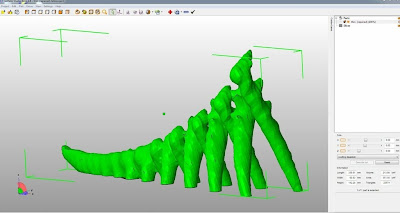Since my plan is to eventually print sculptures that are primarily organic in form, I decided to create a more interesting test print (rather than the basic geometric forms I've been using lately).
Earlier this year, I used Bryce 7 Pro to create some fractal based landscapes which filled the print bed of my Prusa Mendel 3d printer. It was a quick modeling solution, but I think this time not appropriate for this particular test. The print time for a Bryce Pro landscape on this printer would take days, rather than hours.
My solution this time for creating a test model is a freeware program called Incendia Ex. It's a traditional fractal generator that has the very useful function of allowing a generated form to be saved as an .obj or .stl file.
 |
| Incendia Ex |
Once I had a 3d model generated by Incendia Ex, I then needed to import it to a 3d modeling program for modification. Most of my experience using 3d modeling software to date has been with Google SketchUp. It’s great for designing 3d printable forms when they are mechanical in nature, but not for organic models. I need a sculpting program that has an artist in mind.
 |
| Hexagon 2.5 |
I’m using Hexagon 2.5 from Daz3d. It's not my first pick of 3d modeling programs, but it’s presently given away free from the software company ( it’s fully functional with a serial number). With Hexagon, I was able to slice forms apart, tighten their connections for structural integrity and cap holes.
 |
| Netfabb |
With the model complete, I had one last step to prepare it for printing. I imported it into the free version of Netfabb. This program basically repaired the mesh of my model of small holes or non-manifold geometry. In order for the model to print correctly, the 3d model’s mesh must be clean and watertight.
The model's size is 330mmx60mmx142mm (13"x2-3/8"x5-1/2”) and took 5 1/2 hours to print.






